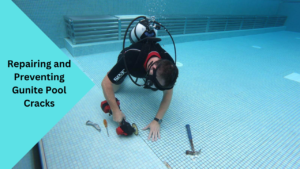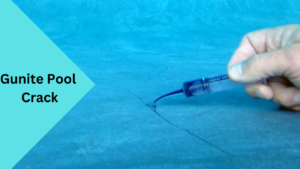Are you considering investing in a gunite pool but worried about potential cracks? Gunite pools are a popular choice for their durability and customizable design options. However, it’s natural to have concerns about their long-term durability. In this comprehensive guide, we’ll explore the common causes of gunite pool cracks, how to identify structural cracks, repair options, and preventive measures to maintain a crack-free pool. Let’s dive in and separate fact from fiction when it comes to gunite pools.
What is Gunite?
Gunite is a type of concrete commonly used in pool construction. It consists of a mix of cement, sand, and water, which is sprayed onto a steel frame or rebar structure. This application method allows for intricate shaping and customization, resulting in a unique and long-lasting pool. To explore more details and considerations regarding Gunite Pool, our comprehensive guide on Exploring Gunite Pools: Pros and Cons has you covered.
Common Causes of Gunite Pool Cracks
- Natural settling and ground movement: Over time, the ground beneath a pool can shift and settle. This movement can put pressure on the pool structure, leading to cracks in the gunite.
- Improper construction or installation: Inadequate compaction of the ground before pool construction, poor reinforcement placement, or incorrect application of the gunite can all contribute to future cracks.
- Freeze-thaw cycles: Freezing temperatures can cause the water within the gunite to expand, creating internal pressure. This expansion, combined with the contraction during thawing, can result in cracks.
- Chemical imbalances and water damage: Improper pool chemistry, such as high levels of acidity or alkalinity, can corrode the gunite surface. Additionally, water damage from leaks or excessive moisture can weaken the structure and lead to cracking.
How to Identify Structural Pool Cracks
Knowing how to spot structural cracks in your gunite pool is essential for taking appropriate action. Here are three methods to help you identify potential structural issues:
- Visual inspection: Take a close look at your pool’s interior surface for any visible cracks. Structural cracks in gunite pools are typically wider than hairline cracks and may appear jagged or extend into the surrounding areas.
- Using a dye test: Perform a dye test to confirm whether a crack is affecting the pool’s structure. This involves placing dye near the suspected crack and monitoring if it seeps through to the other side, indicating a structural issue.
- Seeking professional advice: If you’re unsure about the severity or implications of a crack, it’s recommended to consult with a pool professional experienced in structural pool repairs. They can assess the situation and provide accurate guidance.
Repairing and Preventing Gunite Pool Cracks

If you discover a crack in your gunite pool, addressing it promptly is crucial to prevent further damage. Here are some steps to consider for repairing and preventing pool cracks:
Structural crack repair cost
Before diving into repairs, it’s important to understand potential costs. The cost of repairing a structural crack in a gunite pool can vary depending on the severity and extent of the damage. Consulting with a professional will help determine the specific repair cost for your pool.
Steps for fixing a cracked gunite pool
- Drain the pool: Begin by draining the pool to expose the crack and ensure a clean repair process.
- Prepare the crack: Clean the crack thoroughly and remove any loose debris or damaged material. This will help create a solid foundation for the repair materials.
- Acquire the right materials: Obtain a suitable pool-grade epoxy or hydraulic cement compound to fill the crack. Follow the manufacturer’s instructions for proper application.
- Apply the repair material: Apply the chosen repair material into the crack, ensuring it fills all the crevices and adheres firmly to the surrounding gunite. Smooth the surface for a seamless finish.
- Allow adequate curing time: Give the repair material sufficient time to cure as per the manufacturer’s instructions before refilling the pool.
Read More : How To Fix a Leaking Pool Waterfall
Maintaining proper chemical balance
Regularly test and maintain proper chemical balance in your pool water. This includes monitoring pH levels, alkalinity, and sanitizer levels. Properly balanced water helps prevent damage to the gunite and reduces the risk of cracks.
Avoiding freeze-thaw damage
Protect your pool from freeze-thaw damage by winterizing it during colder months. Lower the water level, add pool antifreeze, and cover the pool with a secure winter cover. This precautionary measure helps minimize the expansion and contraction of water within the gunite, reducing the risk of cracks.
The Disadvantages of Gunite Pools
While gunite pools offer numerous advantages, it’s essential to consider the potential drawbacks before making a final decision. Here are some disadvantages associated with gunite pools:
- Higher initial cost: Gunite pools generally have a higher upfront cost compared to other pool types due to the complex construction process and customization options.
- Potential for cracks and leaks: Although gunite pools are durable, the risk of cracks and leaks exists. Proper maintenance and prompt repairs are essential to address any issues that arise.
- More maintenance and upkeep: Gunite pools require regular cleaning, chemical balancing, and occasional resurfacing to ensure longevity. Maintenance efforts should be factored into the overall pool ownership experience.
The Life Expectancy of Gunite Pools
With proper care and maintenance, a gunite pool can provide decades of enjoyment. The life expectancy of a gunite pool depends on various factors, including regular maintenance, climate conditions, and usage. Here are some considerations to maximize the lifespan of your gunite pool:
- Factors affecting lifespan: Proper chemical balance, regular cleaning, prompt repair of cracks or leaks, and safeguarding against freeze-thaw cycles all contribute to extending the life of a gunite pool.
- Proper maintenance and care tips:
- Regularly test pool water and maintain appropriate chemical levels.
- Clean the pool’s surface and equipment regularly to prevent buildup and potential damage.
- Address any cracks or leaks promptly to prevent further structural deterioration.
- Winterize the pool during colder months to minimize freeze-thaw damage.
By following these maintenance practices, you can increase the longevity of your gunite pool and enjoy it for many years.
Conclusion
Gunite pools are a fantastic investment that can provide years of enjoyment for you and your family. While cracks can occur due to a variety of reasons, addressing them promptly and taking preventive measures can help maintain a crack-free pool. Regular maintenance, proper chemical balance, careful monitoring, and prompt repairs are vital to ensure the longevity and durability of your gunite pool. Remember, hiring a professional for repairs and periodic inspections can go a long way in preserving the overall integrity of your pool. So go ahead and dive into the world of gunite pools, knowing that with proper care, they can bring you years of endless summer fun.

Greetings, fellow pool enthusiasts! I’m Turner Davis, your dedicated guide to the world of pool care and maintenance. With over a decade of experience in the field, I’ve made it my mission to transform ordinary pools into extraordinary aquatic retreats.

